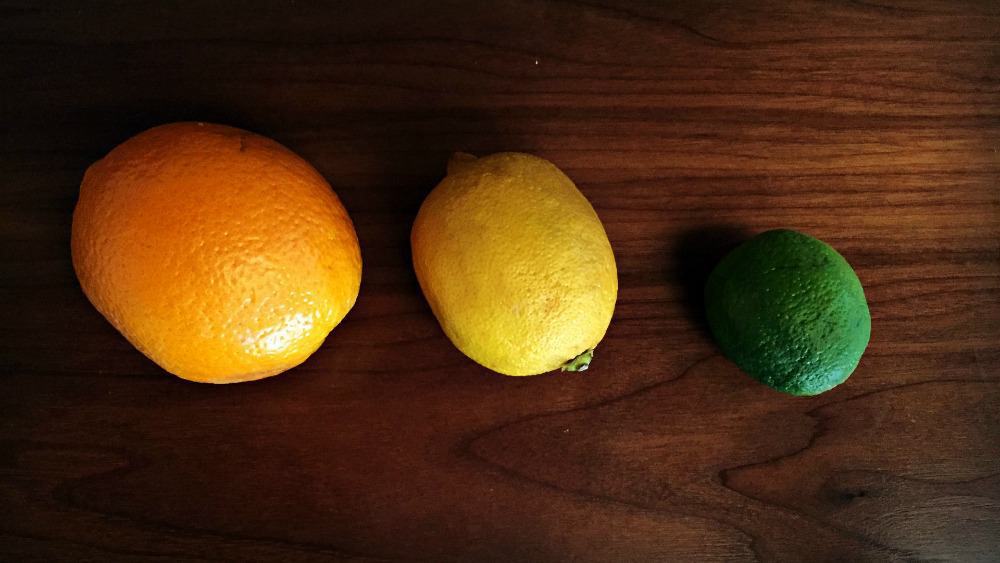
What Makes a Lime a Lime?
If we set aside the actual flavor of the fruit, the acidity and richness of citrus comes from:
- How acidic it is (pH) – think of this as the “intensity” of the acid
- How much sugar there is to balance out the acidity.
Common limes and lemons have very similar pH, but since lemons tend to have more sugar we think of them as being “less sour”. (In actuality, their pH ranges overlap, so it’s possible a lemon may taste more or less sour than a lime. The pH range for lemons is slightly less acidic, though, and their sugar content generally higher.) Likewise, oranges have an even higher pH (even less sour still) and far higher sugar content than both, resulting in an overall sweeter taste.
- I didn’t tell you specifically which varietal of lime, lemon or orange we were talking about
- I didn’t mention seasonality or how ripe the fruit is
- I assumed we’re talking about fresh juice, not something that’s been reconstituted from concentrate.
Different Kinds of Citrus:
Behind the bar in the USA, you’re most likely to be working with Persian Limes and Eureka Lemons. But that doesn’t mean you’ll always be using those. As availability changes (and depending on your geographic location) you could certainly be using different types of citrus. Of course, this also means you can choose different kinds of citrus because of their different qualities.
Key Limes in Cocktails
The Key Lime, for example, is both smaller and more acidic than the common Persian lime. (It’s also tiny, meaning it can take many times as many limes to get the same amount of juice. Don’t say I didn’t warn you!) Due to their intense acidity, a key lime might be a good choice if you want more “kick” without more volume. On the other hand, if your recipe calls for “regular” lime juice and all you have is Key Lime, you may consider watering it down ever so slightly to bring down the acidity a notch. (Tasting will be key here!)
Meyer Lemons in Cocktails:
On the other hand, Meyer Lemons present the opposite challenge. An increasingly easier to find citrus, Meyer Lemons are actually a hybrid cross between a lemon and a mandarin orange. As a result, the fruit still tastes like lemon but is both less acidic and has a higher sugar content. If using Meyer Lemons in the place of “normal” lemon juice, you may need to increase the quantity of the lemon juice and reduce the quantity of other sweeteners in the cocktail.
Spoiler: Pink Lemons
Coming later this week is a cocktail recipe for a Pink Lemon Collins. Our local grocery store had a whole display of these tiny pink citrus and (naturally) we had to grab some to give them a try. I’ll include a link here when it’s published, but just know that we were very surprised at how much adjustment was necessary to account for the sweetness in this guy!
Update: here’s that recipe!

Nerding Out
Unless you’re using a non-fresh juice product (like frozen, pasteurized or re-constituted concentrate), you’re going to see variability in nearly every shipment. The simplest way to solve this problem is by tasting your citrus. But for those of you out there who can’t help yourselves (ahem, Chris), there are some measurement tools you can use to further analyze the fruit you have – and perhaps refine your recipes as a result. (Affiliate links)
- A pH Meter will help you test the acidity of the fruit
- A refractometer is designed to test sweetness
Like this kind of article?
This is just the beginning! There’s a lot more where this came from in our Cocktail Design Program!

Key Takeaways:
When working with branded products like “Ketel One Vodka” or “Bulleit Bourbon” you can be certain you’re getting a consistent product that’ll act the same way in every cocktail. But with fruit, and especially citrus, there’s a huge variance in the characteristics of the juice, across species and even within. Keep tasting your drinks (sanitarily, please) and adjust as necessary.



